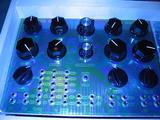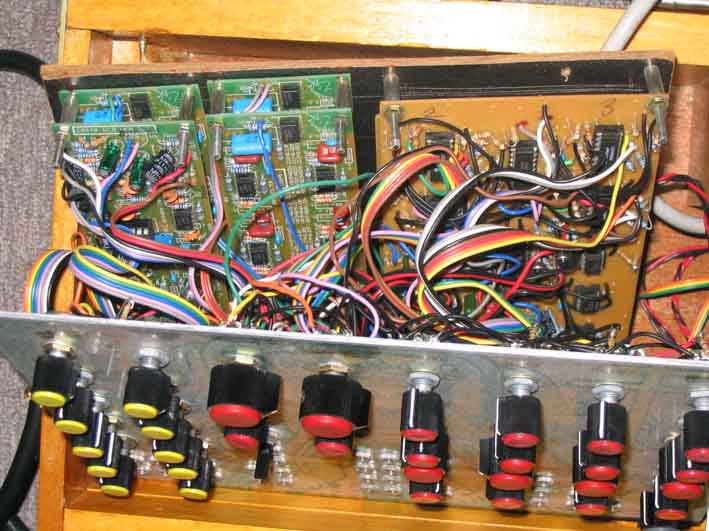
CGS CV mega mixer, CGS sub-oscillator/harmonic sequencer

CGS basic wavefolder, CGS metalshop, CGS cascade mixer, CGS analogic, CGS CV cluster, CGS dysfunctional LFO (was a super psycho but i ran out of panel space, so it got 2 dual speed pots instead of 6 singles)

Ian Fritz's 5pulser and double pulser. John Blacet's Digital pattern generator and Frequency divider

CGS wavetable and Modulo, two of my favorites. Kaos is a sn76477 circuit based on an early Darkstar chaos design. Control is still being planned but will also be a sn76477 chip.

dual passive ring modulators. Other modules in this synth include CGS - gated comparator, infinite melody, analog shift register, diatonic converter, burst generator, pulse divider, J.Haible VCA, R.Schmitz ADSR, MS20 LFO, Kunii San's LFO and a Frequency Shifter panel containing a modified CGS VCO, 2 CGS dome filters, quad oscillator, Lissajous pattern generator, four 1496 based ring modulators, 2 passive ring modulators and associated circuits from Electronotes

upper left - EFM VCO4e, FarmVCO3, EFM VCO4e, Buchla 258 clone (this is awesome - thanks Mark Verbos) .Upper Right - CGS sub oscillator, CGS wave multiplier. Lower Left - two Farm/Steiner VCFs, MS20 VCF, Farm VCSVF (all from Motohiko Takeda's VCF heaven), CGS psycho LFO. LOwer Right - two Farm VCAs, Korg/Roland VCA, CGS tube VCA, four Farm envelope generators

There's nothing fancy in the construction. The panels were cut from a sheet of aluminium and hand-drilled. i created the panel templates in Front Panel Designer, printed them out and used the prints as a drilling guide. The labels are a printable clear 'contact film' (some with inbuilt glitter). To get the image and labelling on i ran them thru the printer twice, 1st for the image, 2nd for the labelling. Then stuck the contact film to the panels and covered them with an 'industrial strength' (read - thick) contact as protection. I like personalised colourful synths, why go for black panels/white lettering?? The cases are made of the cheapest wood i could buy at the local 'Do It', being Japan that was quite expensive and not the nicest timber. Anyway they cut the wood to the customers specs, which saved me a lot of work. I put it all together with lots of bracing and has proved to be very strong (and heavy), painted with some stain of unknown brand (cheapest). The power supply has been thru a few incarnations but the latest is +/-15V 4A hand etched PCB, torroid transformer, built into a separate little (tool)box with a cooling fan.

These days (6/2006) i do my best to spend no money on synth building, except for PCBs from Ken, (unleaded) solder and a good stock of chips i brought home from Japan. Have been lucky enough to score two huge studio mixers (one had been pushed out of a 2nd floor window) which have given me a lifetime supply of pots, sliders and op-amps. my other goldmine is the recycling corner behind the Physics Dept at Uni, they throw away the best stuff, a lot of it is old - 60s, 70s, so plenty of good parts for analogue lovers. Synth DIY can be a very cheap hobby with a bit of effort, though you can end up with a shed full of dead electronic junk, if you are not careful.

Paia 9700 series VCFs and VCAs

vcf heaven! 2 steiners, ms20 clone, vc state variable filter - all from Motohiko Takeda's homepage, including his very compact pcb layouts. along the bottom is a CGS psycho lfo

VCO panel - 2 EFM VCO4s, Takeda San's VCO3, Buchla 258 clone (!!!) it took me 3 tries to etch a pcb for this but it was worth it, i usually use this Vco to drive my CGS Wavetable

CGS sequential switch, dc mixer, vc divider

CGS vco, CGS V8 simulator, 2 Farm vcoIII's (aka Takeda)

was MTS-100 midi2cv, but the magic smoke escaped when i dropped a patchcord across +5V and -15V terminals, no big stress as i never use midi anyway. now it has a 2 big holes, a joystick controller, Blacet VC clock and a BIG bass drum (from Polyphony).





